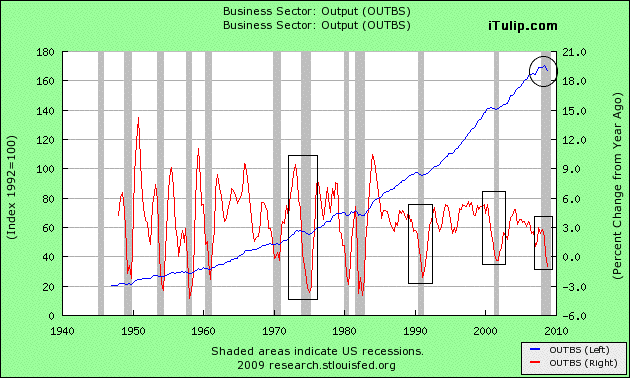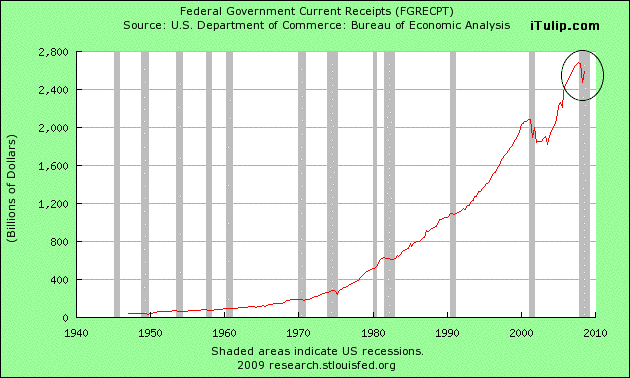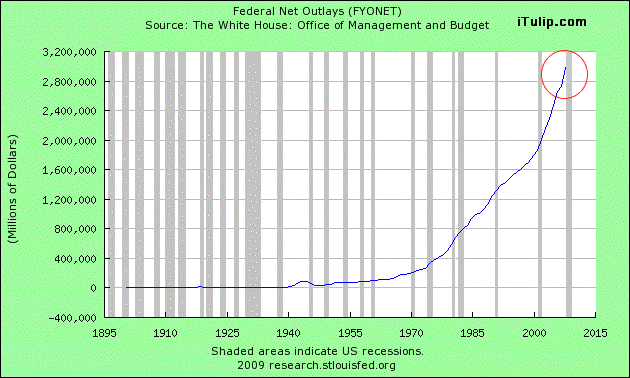 |
We have for ten years made the case for high inflation as an outcome when the US economy, heavy with public and private sector debt, meets debt deflation in an eventual crisis. Yet we have remained just as skeptical about the hyperinflation spiral case as we have about the deflation spiral case represented by Mike Shedlock since 2005.
Respected contrarian market commentators recently issued warnings of imminent hyperinflation in the US, most notably economist John Williams, purveyor of alternative and de-politicized government statistics at ShadowStats, and Jim Sinclair, the granddaddy of gold-centric geopolitical market analysts. In recent weeks their warnings are increasingly urgent. Lately Williams is pressing his followers to double down on gold and stock up on Whiskey for barter, while Sinclair proclaims “this is it” as in “the big one” that the doomers have warned about for decades.
As we noted back in 2001, the US is certainly on the road to hyperinflation. Inflation is the policy, the answer to every ill. But the road from inflation to hyperinflation is long, and there are ways to get off. Carmen M. Reinhart, Deputy Director, and Miguel A. Savastano, Advisor, IMF Research Department in June 2003 published “The Realities of Modern Hyperinflation” to make the case that, despite falling inflation rates worldwide, hyperinflation could happen again:
AFTER World War I, a handful of European economies succumbed to hyperinflation. Austria, Germany, Hungary, Poland, and Russia all racked up enormous price increases, with Germany recording an astronomical 3.25 million percent in a single month in 1923. But, since the 1950s, hyperinflation has been confined to the developing world and the transition economies. The milder problem of chronic high inflation ceased to be a problem in the advanced economies in the 1980s and in the developing countries in the 1990s.
The benign inflation environment of recent years may lead some to believe that chronic high inflation and hyperinflation have been eradicated for good. History suggests that such a conclusion is not warranted. Mainly to keep this important issue at the forefront of policy debate, this article reviews the broad patterns in key macroeconomic policies and outcomes in all episodes of hyperinflation that have occurred in market economies since the mid-1950s.
The article goes on to list “the seven lessons that emerge from this overview of modern hyperinflations” that “policymakers would do well to bear in mind.” We list them below with comments relating them to the US case, noting that while the IMF is not issuing disinterested advice, there is still value in the analysis.The benign inflation environment of recent years may lead some to believe that chronic high inflation and hyperinflation have been eradicated for good. History suggests that such a conclusion is not warranted. Mainly to keep this important issue at the forefront of policy debate, this article reviews the broad patterns in key macroeconomic policies and outcomes in all episodes of hyperinflation that have occurred in market economies since the mid-1950s.
1. Hyperinflations seldom materialize overnight and are usually preceded by a protracted period of high and variable inflation.
Note: The Great Inflation of the late 1970s and the inflationary energy cost-push inflation 2004 to 2008 are unlikely to produce rising inflation expectations, especially when the mainstream financial press beats the deflation drum. Of the seven lessons of hyperinflations, this one applies the least to the US case.2. Stabilization may take years if fiscal policies are not adjusted appropriately. Even when fiscal adjustment is implemented, it takes time to achieve low inflation, especially when money is used as the nominal anchor.
Note: The question of monetary anchor in a dollar hyperinflation is interesting because the dollar has itself has for decades acted as a monetary anchor for nations experiencing hyperinflation. Recall a brief period when the dollar declined to 40% against the euro and street vendors in Vietnam, for example, stopped accepting dollars. If the dollar is a monetary anchor, then what is the dollar’s monetary anchor? It is nothing more than the faith that the US government will take the necessary steps to halt inflation should it arise, as in the early 1980s when fiscal austerity put the US economy into two wrenching recessions that brought inflation down from double digits to zero. Sound economic, fiscal, and monetary management is the nominal anchor for the US dollar.3. Sharp reductions in fiscal deficits are always a critical element of a stabilization program, regardless of the choice of monetary anchor.
Note: The previous example of the early 1980s US case notwithstanding, coming from the IMF this advice is directed at countries that are clients of the IMF, such as South Korea during the 1997-1998 currency crisis, not the IMF’s primary patron, the USA itself. It is important to remember that the US economy was growing and the US was a net creditor at the time the US government undertook austerity programs in the early 1980s. Today the US starting position is closer to that of nations that do experience hyperinflation, large external debts and falling output. Under the same circumstances that call for austerity and constrained fiscal spending in South Korea, we expect the US will continue to take the opposite approach and further increase fiscal deficits, despite the risks. Of the seven lessons of hyperinflation, this is the one that we most need to keep an eye on in the US case.4. Unifying exchange markets and establishing currency convertibility are often essential ingredients of stabilization, irrespective of the choice of main nominal anchor.
Note: Again, this advice is directed at IMF clients not the US. Our contacts tell us that South Korea, Malaysia, Indonesia, and other Asian nations that have built substantial currency reserves since the 1997 to 1998 crisis do not intend to follow the IMF plan and allow their currencies and economies to be wrecked, again. They are aware that their reserves make them targets for speculators. To our knowledge, all of them plan to immediately impose capital controls to thwart any future attack on their currencies. The US will, of course, do likewise should it be threatened with the risk of capital flight. This will help contain the cycle of currency depreciation and cost-push inflation that feeds a hyperinflation. Jim Sinclair rests his hyperinflation case on cost-push inflation from a collapsing dollar resulting from capital fight. We don’t see it; the US will shut it down. Open exchange markets and currency convertibility only apply to IMF clients during crisis, not to the US. In any case, the IMF’s Asian clients learned their lesson, although their newer clients in eastern Europe apparently didn’t learn Asian crisis lesson.
5. Output collapses during, and sometimes in the run-up to, hyperinflation. Although stabilization measures cap the implosion in economic activity, there is little evidence to suggest that they kindle a robust rebound in economic activity.

Output: Rapid Decline

Federal Government Receipts: Rapid Decline

Federal Government Outlays: Rapid Rise
Note: There can be little doubt that US economic output and government receipts are shrinking rapidly while government outlays are rising. Only time will tell how the decline in output figures into a possible hyperinflation future.
6. Hyperinflations are accompanied by an abrupt reduction in financial intermediation.
Note: In other words, when money ceases to function as a store of value, people stop using it. They resort to cash transactions and barter -- John Williams recommends whiskey. During the Russian hyperinflation in the early 1990s vodka was the primary item of barter, so his suggestion is not off-the-wall if in fact a US inflation developed to hyperinflation levels.7. Stopping a hyperinflation does not restore demand for domestic money and domestic currency assets to the levels that prevailed before the hyperinflation began. Capital returns to the country when high inflation stops, but dollarization and other forms of indexation dominate financial intermediation for many years.
Note: Once a hyperinflation has wiped out everyone’s savings, the disaster is not soon forgotten. The currency of the country where the hyperinflation happened is branded a risk, as is every asset that is denominated in it. Before we go further, let’s be clear about what a hyperinflation really means in practical, every day terms.
- Imagine taking every long term contract in your file cabinet – your mortgage, auto loan, student loan, insurance policy, health care insurance, and so on – and ripping them up. There is no insurance or credit in a hyperinflation. All transactions are cash or barter.
- Imagine an ongoing public panic into non-paper assets. In the early stages of a hyperinflation, the most efficient inflation hedges, due to their compact size and liquidity –- precious metals -- disappear in a few weeks. At extremes of hyperinflation, over 1000% per year, hoarding becomes absurd, with items of seemingly little value used as stores of value, such as copper plumbing fittings and brass doorknobs. Anything made of copper, brass, lead, aluminum that is not either nailed down or guarded is stolen and used as a substitute for cash.
- Imagine society breaking down. Money based relationships disintegrate. As the purchasing power of everyone’s savings is gone, everyone becomes completely dependent for cash for day-to-day survival from income earned from whatever they can do or sell. Employers index salaries to inflation, but as the economy will have come to a standstill and output has collapsed, the unemployment rate will exceed 50%. Without tax revenue, state and local governments are crippled, and the police are as desperate as everyone else. Crime flourishes. (A friend recently back from Argentina told me that he was repeatedly stopped by police on the street and asked for money.)
On the international scene, for any country that uses the dollar as a nominal anchor to stabilize its own currency, a dollar hyperinflation means certain hyperinflation for them, too. Countries will de-peg from the dollar before that happens; likewise countries that use the dollar for international trade will drop the dollar.
We all remember what happened in countries that use the dollar for oil trade as the dollar fell 40% between 2002 and 2008: inflation surged in the Middle East, food prices soared, and food riots broke out in some countries. Cost-push inflation in the US worked its way from energy prices into food and other goods until the crash mid-2008. In a hyperinflation, that cost-push inflation process becomes extreme; as the dollar weakens, oil prices rise, and countries using the dollar for trade settlement are forced to drop it and use an alternative currency or their own, as Russia did. The process of de-pegging from the dollar and dropping the dollar for trade will reduce global demand for dollars and weaken the dollar further, leading to more inflation for countries that continue to use the dollar for trade. In Part Two, we talk about this process in our description of ten hyperinflation processes that are common to all hyperinflation episodes and a few that are unique to the US dollar as a reserve currency.
The Hyperinflation Case: Too dark for us?
Maybe we simply lack imagination, but we have had a hard time accepting the above dire scenario for the US. If it happens we're all going to need more than a few bottles of whiskey to get through it. It means the end of the US as we know it, both the society and the nation's international standing.
Partly our optimism is due to the fact that only a few of the IMF’s hyperinflation preconditions are present for the US, and because the US political system, for all of its flaws, is more likely to lead to policy interventions before a period of high inflation develops into a true hyperinflation spiral; as in 1980, the US government can move to restore the nominal anchor for the dollar: sound fiscal and monetary management.
On the other hand, our current bind is unique. Federal and state governments have depended heavily on capital gains taxes from asset price inflation in the FIRE Economy since the early 1980s, and selling ever increasing amounts of debt to private and public investors at home and abroad. In the wake of the collapse of the FIRE Economy since mid 2007, as asset prices and incomes fall, Federal receipts are declining along with economic output and GDP, while federal outlays are exploding due to fiscal stimulus programs. By our calculations, if GDP falls only 4% this year while receipts fall 8% -- last year they were supported by a surge in foreign borrowing that grew 6% per quarter -- and outlays increase only by the $790 billion already committed, the fiscal deficit/Real GDP ratio rises well above 5% this year and 10% next. Those are third world fiscal deficit/GDP levels. To prevent this the US needs to cut fiscal outlays, or raise taxes, or both, during a depression when aggregate demand is collapsing due to the loss of purchasing power by households and businesses in the wake of the now collapsing credit bubble.
We can be certain that US politicians are watching as governments around the world fall along with the collapse of national economies:
Latvian PM quits as crisis bites
Feb. 19, 2009 (BBC)
Latvian Prime Minister Ivars Godmanis and his government have resigned, amid political turmoil triggered by the Baltic state's economic crisis.
Latvia and Iceland the leading edge of a series of government resignations. Can the UK and Japanese governments be far behind? Feb. 19, 2009 (BBC)
Latvian Prime Minister Ivars Godmanis and his government have resigned, amid political turmoil triggered by the Baltic state's economic crisis.
While the deflation spiral case can be dismissed as irrelevant in our post gold standard world (see The truth about deflation), we cannot accept as an article of faith that the American political system will necessarily allow the US government to "do the right thing" to avoid taking the current inflation path to its logical conclusion. Political pressure to try to preserve the system in the short term at the expense of the long run is too great.
We do not conclude our review of the hyperinflation scenario based on the IMF’s narrow survey and self-serving conclusions. With nose held and peeking between two fingers of our hands plastered to our faces in horror at the implications, we take a serious look at the hyperinflation case. We studied dozens of high inflations and hyperinflations, ancient and modern, and have come to our own conclusions that we believe are more broadly applicable, even to the US case, and more politically independent than the IMF’s.
The most relevant and worrisome factor is that the US is heading into an economic depression in a marginalized fiscal position, and with heavy external debts – even if they are denominated in dollars -- as well as large gross public debt, and heavy household and corporate debt burdens, as output and GDP declines. The combined negative infuence of these pre-conditions may outweigh the unique advantages that the US has over countries that have suffered hyperinflation: the status of the dollar as a reserve currency and the interests of US trade partners to cooperate with the US and each other to avoid taking losses in the purchasing power of the dollar-denominated assets they hold. To answer how these conflicting factors may work out over time we break down the macro-process of hyperinflation into its various interacting sub-processes and build our case bottom-up.
Hyperinflation case revisited - Part Two: How Hyperinflation Happens ($ubscription)
Moderate inflation need not develop into a high inflation and then into a hyperinflation. At any point, any government can take steps to end an inflation; the question is, at what political cost? Depending on how far the inflation process has developed, and how much political trouble the government is in, ending inflation can be accomplished by a combination of two steps: one, pegging the currency to a nominal anchor, such as another more stable currency or to a fixed asset, such as land or gold, and, two, addressing the primary cause of all hyperinflations: fiscal mismanagement. In addition to the currency losing its nominal moorings and loss of fiscal discipline, the third root cause of hyperinflation is foreign debt, but this may be wiped out by the inflation itself even before hyperinflation sets in. more... ($ubscription)
See also:
The truth about deflation
Deflationistas, inflationistas, and hyperinflationistas
Fed cuts dollar, Fire sales vs FIRE sales, Duh-flation, and Bezzle shrinks again
iTulip Select: The Investment Thesis for the Next Cycle™
__________________________________________________
To receive the iTulip Newsletter or iTulip Alerts, Join our FREE Email Mailing List
Copyright © iTulip, Inc. 1998 - 2009 All Rights Reserved
All information provided "as is" for informational purposes only, not intended for trading purposes or advice. Nothing appearing on this website should be considered a recommendation to buy or to sell any security or related financial instrument. iTulip, Inc. is not liable for any informational errors, incompleteness, or delays, or for any actions taken in reliance on information contained herein. Full Disclaimer

 Do not feel bad!
Do not feel bad!
Comment